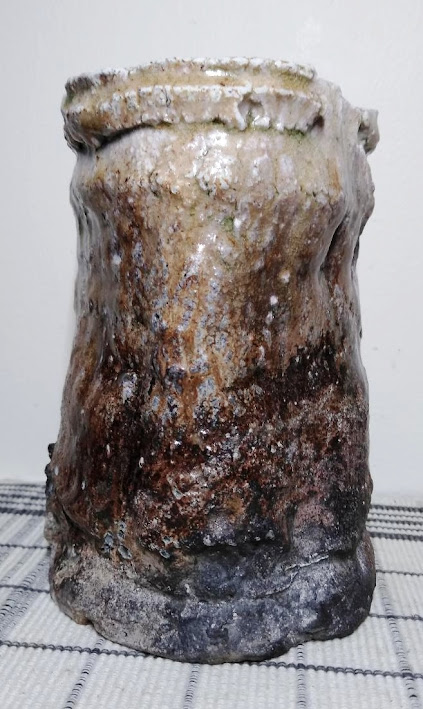226. SUGIMOTO Sadamitsu 杉本貞光 , 1935- , 伊賀花入 Iga hanaire (radical Iga vase with shinshoku 侵食 effects)
Sugimoto Sadamitsu was born in Tokyo in 1935. A strong adherent of the Zen tradition, Sugimoto established his own kiln at 33, receiving the kiln name Teragaito 寺垣外 (meaning "outside the temple walls") from his mentor, Daitokuji priest Tachibana Daiki (some sources read the given name Oki), who also inscribed the box for this piece. He has spent his life studying kohiki, Shigaraki-, Iga-, and Raku- wares. Sugimoto is largely self-taught in pottery. He has an anagama kiln in the mountains near Shigaraki.
Gray clay, with kiln effects in the pink, red, reddish brown, gray, and black ranges, with natural ash glazing and vitrification over much of the exterior and interior surfaces, with a couple of bidoro green glass beads on the sides and along the rim. Weight: 1844 g (4.1 lb). Height: 19 cm (7-1/2 in). Diameter of base: 13.5 cm (5-3/8 in).
The base is roughly circular with many pits and breaks. It is slightly concave toward the center. The piece sits on the flatter, outer edges of the base. The artist’s mark, a cross resembling the katakana “na” above a vertical stroke slanting to the right toward the bottom, was incised into the base. This may be a quick version of the first character in his given name, 貞, especially if written in the older style with the vertical line on the left meeting the bottom horizontal line at a right angle. Comparison of the interior depth with the external height shows that the base is roughly 1.3 cm (1/2 in) thick. For the first 2.5 cm (1 in) or so, the walls of the piece are roughly circular. Above that the vase is shaped into a three-sided piece with rounded corners. A roughly 2-cm (3/4 in)-wide strip attached to the outside encircles the rim. The rim itself is 1.3 cm (1/2 in) thick. The triangular shape of the piece is most noticeable from the top; the three sides are about 12 cm (4-3/4 in) long at the top.
The walls are dented, pitted, and encrusted with blobs of clay. At the top, the rim suffered what is known as shinshoku 侵食 in Japanese pottery—the fire was so hot that the clay melted—forming a break in the piece. The dictionary translation of shinshoku is “erosion” or “corrosion,” but those English terms seem too passive to me. The Japanese characters imply an aggressive, active attack—something more like “eat at” or “devour” captures the meaning better, I think. I asked Robert Mangold, the owner of the Kura Monzen Gallery, if the artist had done something to produce this effect intentionally. He replied, “Shinshoku is mostly about kiln placement and firing time. I do not think a potter would weaken a piece, as that would make it quite difficult to control, and you would have a great chance of losing it altogether. Not ideal considering the size of the kilns and the limited space for Hai Kaburi [灰被 = natural ash glazing] pieces.” The surface of this varies from smooth over the vitrified areas to very rough over the unglazed portions.
This was unglazed. The colors and the glossy surface are the results of kiln effects and natural ash glazing. The front (arbitrarily the side with the shinshoku and the left sides received the most ash glazing. The right side was left largely untouched, as was the base, and was colored red by the heat. Almost all the interior is covered with a vitrified ash glaze. The is one long bidoro glass bead on the exterior, as well as areas of green bidoro deposits on the rim and the interior.
This
came in a wooden box with a blue cloth, with calligraphy by the monk
Daiki on the top and underside of the lid and on the bottom of the box. The
characters on the top read, in two rows: 伊賀花入 Iga hanaire (vase), and 貞光造 Sadamitsu-zō (made by Sadamitsu). Those on the underside, also
in two rows, read: 紫野 Murasakino (a placename in Kyoto and the
location of the Daitokuji Temple) and 大亀 Daiki, followed by Daiki’s kaō sigil. (A kaō 花押 sigil is a stylized form of signature used
by tea practitioners.) The characters on the bottom, in three groups
read: in the upper right corner: 信楽 (Shigaraki); in the lower right corner in two lines: 寺垣外 (Teragaito) and 貞光 (Sadamitsu); and in the lower left corner: 花入 hanaire (vase).
Purchased from the Kura Monzen Gallery in Kyoto, Japan in July 2023 (invoice, shipping and customs documents)

















No comments:
Post a Comment